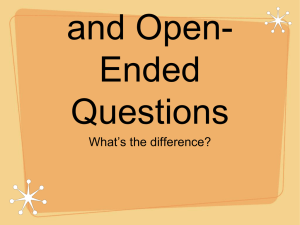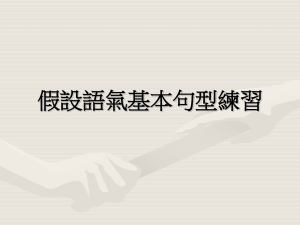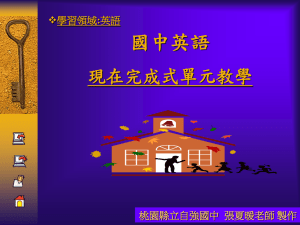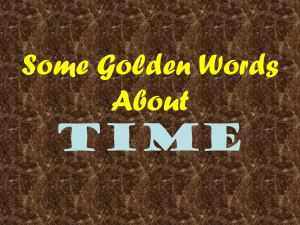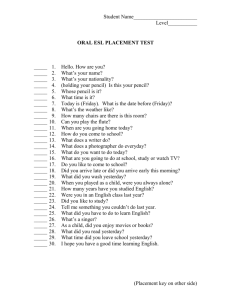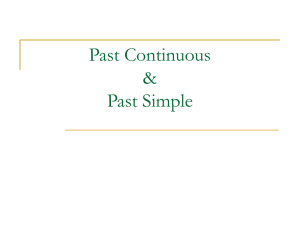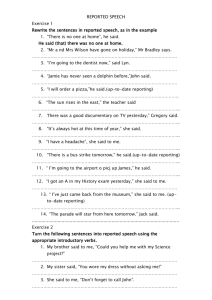The Yesterday & Today (Y&T) Journal for History Teaching in South
advertisement
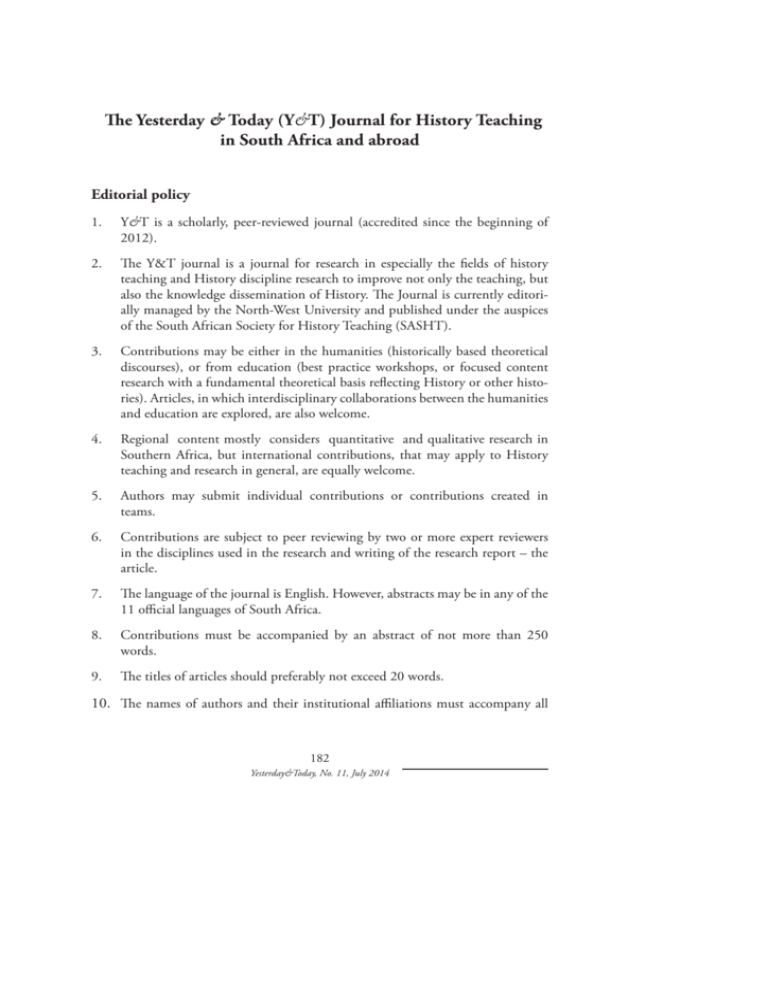
Reference guidelines The Yesterday & Today (Y&T) Journal for History Teaching in South Africa and abroad Editorial policy 1. Y&T is a scholarly, peer-reviewed journal (accredited since the beginning of 2012). 2. The Y&T journal is a journal for research in especially the fields of history teaching and History discipline research to improve not only the teaching, but also the knowledge dissemination of History. The Journal is currently editorially managed by the North-West University and published under the auspices of the South African Society for History Teaching (SASHT). 3. Contributions may be either in the humanities (historically based theoretical discourses), or from education (best practice workshops, or focused content research with a fundamental theoretical basis reflecting History or other histories). Articles, in which interdisciplinary collaborations between the humanities and education are explored, are also welcome. 4. Regional content mostly considers quantitative and qualitative research in Southern Africa, but international contributions, that may apply to History teaching and research in general, are equally welcome. 5. Authors may submit individual contributions or contributions created in teams. 6. Contributions are subject to peer reviewing by two or more expert reviewers in the disciplines used in the research and writing of the research report – the article. 7. The language of the journal is English. However, abstracts may be in any of the 11 official languages of South Africa. 8. Contributions must be accompanied by an abstract of not more than 250 words. 9. The titles of articles should preferably not exceed 20 words. 10. The names of authors and their institutional affiliations must accompany all 182 Yesterday&Today, No. 11, July 2014 Reference guidelines contributions. Authors also have to enclose their telephone and fax numbers and E-mail and postal addresses. 11. The Harvard or the Footnote methods of reference may be used (see the last pages of the journal for the reference guidelines for more detail on the Harvard and Footnote reference methods). The authors’ choice of which reference method will be respected by the editorial management. References must be clear, lucid and comprehensible for a general academic audience of readers. Once an author has made a choice of reference method, the Y&T guidelines for either the Harvard reference method or the Footnote reference method must be scrupulously followed. The guidelines for referencing according to the Harvard method are provided on the last pages of the journal. The most recent Yesterday&Today journal articles could also serve as guideline. 12. Editorial material with images (illustrations, photographs, tables and graphs) is permissible. The images should, however, be of a high-density quality (high resolution, minimum of 200dpi). The source references should also be included. Large files should be posted in separate E-mail attachments, and appropriately numbered in sequence. 13. Articles should be submitted to the editor electronically – at elize.vaneeden@ nwu.ac.za. Notification of the receipt of the documents will be done within 48 hours. 14. The text format must be in 12pt font, and in single spacing. The text should preferably be in Microsoft Word format. 15. The length of articles should preferably not exceed 8 000 to 10 000 words, or 15 to journal pages. 16. Articles which have been published previously, or which are under consideration for publication elsewhere, may not be submitted to the Yesterday&Today journal. Copies of the Journal is also electronically available on the SASHT website at www.sashtw.org.za. 183 Yesterday&Today, No. 11, July 2014 Reference guidelines Yesterday & Today Template guidelines for writing an article 1. Font type: Adobe Garamond Pro (throughout document)/Arial (if the first font type is unavailable). 2. Font size in body text: 12pt. 3. Author’s details: ONLY provide the following: Title, Campus & University and E-mail address Title:10pt, regular font; Campus & University: 10pt, italics; and E-mail address: 10pt, regular font. (Consult previous articles published in the Y&T journal as an example or as a practical guideline). Example: Pieter van Rensburg, Vaal Triangle Campus, North-West University, p.vanrensburg@gmail.com. 4. Abstract: The abstract should be placed on the first page (where the title heading and author’s particulars appear). The prescribed length is between a half and three quarters of a page. The abstract body: Regular font, 10pt. The heading of the Abstract: Bold, italics, 12pt. 5. Keywords: The keywords should be placed on the first page below the abstract. The word ‘Keywords’:10pt, bold, underline. Each keyword must start with a capital letter and end with a semi-colon (;). Example: Meters; People; etc. (A minimum of six key words is required). 6. Heading of article: 14pt, bold. 7. Main headings in article: ‘Introduction’ – 12pt, bold. 8. Sub-headings in article: ‘History research’ – 12pt, bold, italics. 9. Third level sub-headings: ‘History research’ – 11pt, bold, underline. 10. Footnotes: 8pt, regular font; BUT note that the footnote numbers in the article text should be 12pt. The initials in a person’s name (in footnote text) should be without any full stops. Example: LC du Plessis and NOT L.C. du Plessis. 184 Yesterday&Today, No. 11, July 2014 Reference guidelines 11. Body text: Names without punctuation in the text. Example: “HL le Roux said” and NOT “H.L. le Roux said”. 12. Page numbering: Page numbering in the footnote reference text should be indicated as follows: Example: p.space23 – p. 23. / pp. 23-29. 13. Any lists in the body text should be 11pt, and in bullet format. 14. Quotes from sources in the body text must be used sparingly. If used, it must be indented and in italics (10pt). Quotes less than one line in a paragraph can be incorporated as part of a paragraph, but within inverted commas; and NOT in italics. Example: An owner close to the town stated that: “the pollution history of the river is a muddy business”. 15. Quotes (as part of the body text) must be in double inverted commas: “…and she” and NOT ‘…and she’. 16. Images: Illustrations, pictures, photographs and figures: Submit all pictures for an article in jpeg, tiff or pdf format in a separate folder, and indicate where the pictures should be placed in the manuscript’s body text. All visuals are referred to as Images. Example: Image 1: ‘Image title’ (regular font, 10pt) in the body text. Sources of all images should also be included after the ‘Image title’. Example: Source: ‘The source’ (regular font, 9 pt). Remember to save and name pictures in the separate folder accordingly. Important note: All the images should be of good quality (a minimum resolution of 200dpi is required; if the image is not scanned). 17. Punctuation marks should be placed in front of the footnote numbers in the text. Example: the end.1 NOT …the end1. 18. Single and left spacing between the sentences in the footnote. 19. Dates: All dates in footnotes should be written out in full. Example: 23 December 2010; NOT 23/12/2010 [For additional guidelines see the Yesterday & Today Reference guidelines]. 20. Language setting in Microsoft Word as English (South Africa); do this before starting with the word processing of the article. Go to ‘Review’, ‘Set Language’ and select ‘English (South Africa)’. 185 Yesterday&Today, No. 11, July 2014 Reference guidelines The footnote or Harvard reference methods – some guidelines Both the footnote reference method and the Harvard reference method are accepted for articles in Yesterday & Today. See some guidelines below: The footnote reference method Footnote references should be placed at the bottom of each page. Footnotes should be numbered sequentially throughout the article and starting with 1. Archival sources/published works/authors referred to in the text should be cited in full in the first footnote of each new reference. Thereafter it can be reduced to a shorter footnote reference. Do not refer to the exact same source and page numbers in footnotes that follow each other. The use of the Latin word “Ibid” is not allowed. Rather refer to the actual reference again (or in its shortened version) on the rest of a page(s) in the footnote section. The titles of books, articles, chapters, theses, dissertations and papers/manuscripts should NOT be capitalised at random. Only the names of people and places (and in some instances specific historic events) are capitalised. For example: P Erasmus, “The ‘lost’ South African tribe – rebirth of the Koranna in the Free State”, New Contree, 50, November 2005, p. 77; NOT P Erasmus, “The ‘Lost’ South African Tribe – Rebirth Of The Koranna In The Free State”, New Contree, 50, November 2005, p. 77. PLEASE NOTE: Referencing journal titles imply that every word of the journal must start with a capital letter, example: Yesterday&Today Journal. Examples of an article in a journal R Siebörger, Incorporating human rights into the teaching of History: Teaching materials, Yesterday&Today, 2, October 2008, pp. 1-14. S Marks, “Khoisan resistance to the Dutch in the seventeenth and eighteen centuries”, Journal of African History, 3(1), 1972, p. 76. 186 Yesterday&Today, No. 11, July 2014 Reference guidelines Example of a shortened version of an article in a journal From: P Erasmus, “The ‘lost’ South African tribe – rebirth of the Koranna in the Free State”, New Contree, 50, November 2005, p. 77. To: P Erasmus, “The ‘lost’ South African tribe…”, New Contree, 50, November 2005, p. 77. [Please note: ONLY the title of the article is shortened and not the finding place.] Examples of a reference from a book WF Lye & C Murray, Transformations on the Highveld: The Tswana and the Southern Sotho (Cape Town, David Phillip, 1980), pp. 7, 10. JJ Buys, Die oorsprong en migrasiebewegings van die Koranna en hulle rol in die Transgariep tot 1870 (Universiteit van die Vrystaat, Bloemfontein, 1989), pp. 33-34. [Please note: The reference variety to page numbers used.] Example of a shortened version of a reference from a book From: JA Conforti, Samuel Hopkins and the New Divinity Movement: Calvinism, the Congregational Ministry, and reform in New England between the Great Awakenings (Washington, Christian University Press, 1981), p. 23. To: JA Conforti, Samuel Hopkins and the New Divinity Movement…, p. 23. Example of a reference from a chapter in a book S Brown, “Diplomacy by other means: SWAPO’s liberation war”, C Leys, JS Saul et.al, Namibia’s liberation struggle: The two-edged sword (London, Oxford University Press, 1995), pp. 19-39. Shortened version: S Brown, “Diplomacy by other means…”, C Leys, JS Saul et.al, Namibia’s liberation struggle…, pp. 19-39. 187 Yesterday&Today, No. 11, July 2014 Reference guidelines Example of a reference from an unpublished dissertation/thesis MJ Dhlamini, “The relationship between the African National Congress and the Pan Africanist Congress, 1959-1990” (Ph.D, NWU, 2006), pp. 4, 8, 11. Examples of a reference from a newspaper P Coetzee, “Voëlvlugblik ATKV 75 op ons blink geskiedenis”, Die Transvaler, 6 Januarie 2006, p. 8. or Zululand Times, 19 July 1923. Archival references: t*OUFSWJFXT Provide at least key details such as: Name of interviewee and profession; the interviewer and profession and date of interview t&YBNQMFPGJOUFSWJFXSFGFSFODF K Rasool (Personal Collection), interview, K Kotzé (CEO, Goldfields, Johannesburg Head Office)/E Schutte (Researcher, NWU, School of Basic Science), 12 March 2006. t&YBNQMFPGTIPSUFOFEJOUFSWJFXSFGFSFODF(after it has been used once in article) K Rasool (Personal Collection), interview, K. Kotzé/E Schutte , 12 March 2006. t&YBNQMFPGBO&MFDUSPOJD.BJMEPDVNFOUPSMFUUFS E-mail: W Pepler (Bigenafrica, Pretoria/E van Eeden (Researcher), 22 October 2006. t/BUJPOBMBSDIJWFT(or any other archive) National Archive (NA), Pretoria, Department of Education (DoE), Vol.10, Reference 8/1/3/452: Letter, K Lewis (Director General) / P Dlamini (Teacher, Springs College), 12 June 1960. 188 Yesterday&Today, No. 11, July 2014 Reference guidelines [Please note: After the first reference to the National Archives or Source Group for example, it can be abbreviated to e.g. NA or DE.] A source accessed on the Internet A Dissel, “Tracking transformation in South African prisons”, Track Two, 11(2), April 2002 (available at http://ccrweb.ccr.uct.ac.za/two/11-2transformation.html, as accessed on 14 Jan. 2003), pp. 1-3. A source from conference proceedings First reference to the source: D Dollar, “Asian century or multi-polar century?” (Paper, Global Development Network Annual Conference, Beijing, January 2007), p. 7. B Sautmann, “The forest for the trees: Trade investment and the China-in-Africa discourse” (Paper, Public Seminar: China in Africa: Race, relations and reflections, Centre for Sociological Research, University of Johannesburg, 28 July 2007), p. 7. Shortened version: D Dollar, “Asian century...” (Paper, GDN Conference, 2007), p. 7. B Sautmann, “The forest for the trees: ...” (Paper, Public Seminar: China in Africa: ..., University of Johannesburg [or UJ]), p. 7. GENERAL: Illustrations The appropriate positioning of the image should be indicated in the text. Original copies should be clearly identified on the back. High quality scanned versions are always welcome. Authors, PLEASE obtain copyright and reproduction rights on photographs and other illustrations. Copyright on all material in Yesterday&Today rests within the Editorial Advisory Committee of Yesterday&Today. 189 Yesterday&Today, No. 11, July 2014 Reference guidelines The Harvard reference method References in the text References are cited in the text by the author’(s) surname(s) and the year of publication in brackets, separated by a comma: e.g. (Weedon, 1977:13). If several articles by the same author and from the same year are cited, the letters a, b, c, etc. should be added after the year of publication: e.g. (Fardon, 2007a:23). Page references in the text should follow a colon after the date: e.g. (Bazalgette, 1992:209-214). In works by three or more authors the surnames of all authors should be given in the first reference to such a work. In subsequent references to this work, only the name of the first author is given, followed by the abbreviation et al.: e.g. (Ottaro et al., 2005:34). If reference is made to an anonymous item in a newspaper, the name of the newspaper is given in brackets: e.g. (The Citizen, 2010). For personal communications (oral or written) identify the person and indicate in brackets that it is a personal communication: e.g. (B Brown, pers. comm.). Ensure that dates, spelling and titles used in the text are accurate and consistent with those listed in the references. List all references chronologically and then alphabetically: e.g. (Scott 2003; Muller 2006; Meyer 2007). List of references Only sources cited in the text are listed, in alphabetical order, under References. Bibliographic information should be in the language of the source document, not in the language of the article. References should be presented as indicated in the following examples. See the required punctuation. t+PVSOBMBSUJDMFT Surname(s) and initials of author(s), year of publication, title of article, unabbreviated title of journal, volume, issue number in brackets and page numbers: e.g. 190 Yesterday&Today, No. 11, July 2014 Reference guidelines Shepherd, R 1992. Elementary media education. The perfect curriculum. English Quarterly, 25(2):35-38. t#PPLT Surname(s) and initials of author(s) or editor(s), year of publication, title of book, volume, edition, place of publication and publisher: e.g. Mouton, J 2001. Understanding social research. Pretoria: JL van Schaik. t$IBQUFSTJOCPPLT Surname(s) and initials of author(s,) year of publication, title of chapter, editor(s), title of book, place of publication and publisher: e.g. Masterman, L 1992. The case of television studies. In: M Alvarado & O Boyd-Barrett (eds.). Media education: an introduction. London: British Film Institute. t6OQVCMJTIFEUIFTFTPSEJTTFSUBUJPOT Fardon, JVV 2007. Gender in history teaching resources in South African public school. Unpublished DEd thesis. Pretoria: Unisa. t"OPOZNPVTOFXTQBQFSSFGFSFODFT Daily Mail 2006. World Teachers’ Day, 24 April. t&MFDUSPOJDSFGFSFODFT Published under author’s name: Marshall, J 2003. Why Johnny can’t teach. Reason, December. Available at http:// www.reason.com/news/show/29399.html. Accessed on 10 August 2010. Website references: No author: These references are not archival, and subject to change in any way and at any time If it is essential to present them, they should be included in a numbered endnote and not in the reference list. 191 Yesterday&Today, No. 11, July 2014 Reference guidelines t1FSTPOBMDPNNVOJDBUJPOT Normally personal communications should always be recorded and retrievable. It should be cited as follows: Personal interview, K Kombuis (Journalist-singer)/S van der Merwe (Researcher), 2 October 2010. 192 Yesterday&Today, No. 11, July 2014 SASHT Membership form 2014 193 Yesterday&Today, No. 11, July 2014 SASHT Membership form 2014 194 Yesterday&Today, No. 11, July 2014
